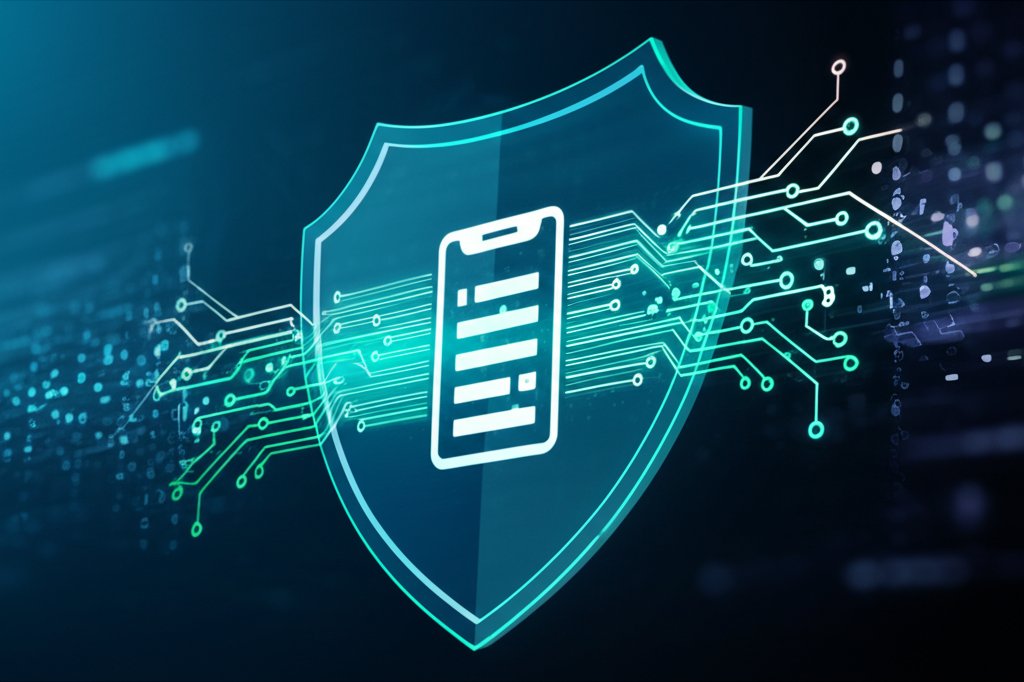The digital world moves fast, and with it, the threats we face online evolve just as quickly. Lately, you can’t scroll through a tech news feed without encountering “AI” being heralded as the ultimate savior for cybersecurity. It’s often painted as a magic shield, a revolutionary force that will make all our digital worries disappear. But for everyday internet users and small businesses, what does security really mean when we talk about AI in application protection, and how can it specifically benefit small and medium-sized enterprises (SMEs)?
AI-Driven Application Security: Separating Hype from Reality for Your Business
As a security professional, my goal is to help you cut through the noise. We’ll explore what AI actually brings to the table for safeguarding your online applications, where the real benefits lie, and where the marketing hype needs a serious reality check. Our aim is to empower you to make informed decisions about your digital defenses, not to alarm you, focusing on practical, actionable insights for your business and personal security.
The Buzz Around AI in Security: What’s Everyone Talking About?
From self-driving cars to personalized shopping experiences, Artificial Intelligence is reshaping industries at an incredible pace. Cybersecurity is no exception. Companies are investing heavily, promising “AI-powered” solutions that can supposedly predict and stop any cyber threat before it even starts. It sounds amazing, doesn’t it?
There’s a good reason for this excitement. The sheer volume and increasing sophistication of cyberattacks today mean traditional, human-led security methods are often stretched thin. We’re talking about millions of potential threats, new attack vectors emerging daily, and the need for constant vigilance. This is where AI, with its ability to process massive datasets and learn from patterns, seems like the perfect answer – a digital guardian that never sleeps. Many are seeking to understand the true AI security benefits for SMEs.
What is “Application Protection” Anyway? (Simplified for Non-Techies)
Before we dive into AI, let’s quickly clarify what we mean by application protection. Simply put, applications are the software programs you use every day: the websites you log into (like your bank’s portal, social media, or online shopping carts), the mobile apps on your phone (banking apps, messaging services), and the business software your team relies on for daily operations (CRM, accounting software, project management tools).
Securing these applications is absolutely crucial because they often hold your most sensitive information: personal data, financial details, private communications, and proprietary business information. A breach in any of these can lead to identity theft, financial loss, reputational damage, regulatory fines, or a complete shutdown of business operations. The scale of cyber threats is immense, and bad actors are constantly trying to exploit vulnerabilities in these applications. That’s why we’re always looking for better, smarter ways to protect them, making application security best practices a non-negotiable for every entity, large or small.
Reality Check: What AI Actually Does for Application Security
So, let’s get real. What can AI truly accomplish when it comes to keeping your applications safe, and how does it deliver genuine AI security benefits for SMEs?
-
Real-time Threat Detection & Anomaly Spotting: Imagine a highly vigilant security guard who can watch a million things at once and instantly know when something is out of place. That’s AI. It rapidly analyzes colossal amounts of data – network traffic, user login attempts, behavioral patterns – to identify unusual patterns and suspicious activities that no human could track. We’re talking about detecting new malware variants, sophisticated phishing attempts (even those using deepfakes), or unusual login attempts from unexpected locations. For a small business, this means proactive defense against a vast array of constantly evolving threats, protecting customer data and proprietary information around the clock. It’s incredibly good at spotting the needle in the haystack.
-
Automation of Repetitive Tasks: Security isn’t always glamorous; a lot of it involves repetitive, time-consuming tasks. AI excels here, automating routine security operations like monitoring logs, running vulnerability scans, and triaging security alerts. This significantly frees up your (or your IT team’s) valuable time to focus on critical strategic issues, such as developing stronger policies or responding to genuine, complex threats, rather than getting bogged down in mundane tasks. This efficiency translates directly into cost savings for SMEs.
-
Enhanced Incident Response: When a threat is detected, every second counts. AI can significantly speed up the reaction time, potentially by automatically blocking suspicious IP addresses, isolating affected systems, or triggering immediate alerts to the right personnel. For a small business, this means the difference between a minor incident and a catastrophic data breach, helping to contain threats before they escalate and cause significant damage.
-
Predictive Defense: AI isn’t just reactive; it can be proactive. By analyzing historical and real-time data, AI models can learn to anticipate and preemptively defend against potential future attacks, identifying emerging patterns before they become widespread threats. This allows your security systems to adapt and strengthen defenses against vulnerabilities even before they are actively exploited.
-
Reducing False Positives: One of the biggest challenges in security is the “noise” – countless alerts that turn out to be harmless. AI can accurately distinguish between genuine threats and benign activities, significantly reducing false positives. This helps prevent alert fatigue among security teams (or business owners wearing multiple hats) and ensures that genuine threats get the immediate attention they deserve, improving overall operational efficiency.
-
Cost-Effectiveness for Small Businesses: You might think AI security is only for enterprises with huge budgets. But because AI-driven tools can automate and enhance efficiency, they can actually reduce the need for extensive human resources dedicated to security. This makes robust, advanced security more accessible and cost-effective for small and medium-sized businesses in the long run, democratizing access to top-tier protection that was once out of reach.
The “Hype” Debunked: Common Myths About AI in Security
Despite its impressive capabilities, it’s crucial to separate fact from fiction. Let’s tackle some common myths head-on, particularly when considering choosing AI cybersecurity solutions:
-
Myth 1: AI is a Cybersecurity Silver Bullet or Makes Your Business Invincible.
Reality: AI is an incredibly powerful tool, no doubt. But it’s just that – a tool. It’s a critical component of a broader, multi-layered security strategy, not a standalone solution. We can’t forget that cybercriminals are also leveraging AI to create more sophisticated attacks, constantly pushing the boundaries of defense. Relying solely on AI is like having an excellent alarm system but leaving your doors unlocked.
-
Myth 2: AI Will Completely Replace Human Security Experts.
Reality: This is a common fear, but it’s simply not true. AI augments and assists human judgment, oversight, and strategic decision-making. It handles the heavy lifting, the data analysis, and the repetitive tasks. Humans provide the intuition, the ethical considerations, the understanding of context, and the ability to adapt to truly novel threats that AI hasn’t been trained on. Think of AI as a powerful co-pilot, not a replacement. Human intelligence remains vital for strategic direction and critical decision-making.
-
Myth 3: AI is 100% Flawless and Always Accurate.
Reality: We wish! AI is only as good as the data it’s trained on. It can exhibit biases, generate false positives or negatives, and genuinely struggle with entirely novel threats it’s never “seen” before. It learns from patterns, so something truly unprecedented can bypass it. Continuous monitoring and human verification are still necessary to ensure accuracy and adapt to zero-day exploits.
-
Myth 4: AI Security is Only for Large Corporations with Big Budgets.
Reality: This might have been true a few years ago, but not anymore. Scalable, cloud-based AI security solutions are increasingly accessible and affordable for small and medium-sized businesses. Many vendors now offer services specifically tailored to smaller organizations, democratizing access to advanced protection and making sophisticated application security best practices within reach.
The Risks and Limitations of AI in Application Protection
While we champion AI’s benefits, we must also be clear-eyed about its limitations and potential risks. An informed approach means understanding the full picture.
-
Adversarial Attacks: This is a growing concern. Attackers can deliberately “trick” AI systems by subtly manipulating inputs. Think of prompt injection in AI chatbots, where malicious instructions are hidden, or data poisoning, where bad data is fed to AI models to corrupt their learning. This means AI-driven defenses can become targets themselves, requiring constant vigilance and evolution of the AI models.
-
Data Privacy Concerns: AI models learn from data, often vast amounts of it. There’s always a risk, however small, that these models could inadvertently memorize or reveal sensitive training data if not designed and managed carefully. We need to ensure ethical data handling, robust anonymization techniques, and compliance with privacy regulations (like GDPR or CCPA) when implementing AI security solutions.
-
“Black Box” Problem: Sometimes, an AI system makes a decision, but understanding why it made that particular decision can be challenging. This “black box” problem can hinder investigations into security incidents or make it difficult to trust the AI’s judgment without human oversight. Explainable AI (XAI) is an emerging field trying to address this, but it remains a significant challenge.
-
New Vulnerabilities: Ironically, AI systems themselves can introduce new types of security risks. If an AI model is compromised or exploited, it could open up new attack vectors that traditional defenses aren’t equipped to handle. It’s a constant arms race where the tools we use for defense can also become targets, necessitating secure development and deployment of AI systems themselves.
Practical Steps for Small Businesses & Everyday Users to Leverage AI Security
So, how can you practically benefit from AI-driven security without getting overwhelmed? Here’s a framework for choosing AI cybersecurity solutions and implementing application security best practices:
-
Don’t Rely Solely on AI: This is my strongest advice. AI is powerful, but it’s part of a layered security approach. Combine AI-driven tools with fundamental practices: always use Multi-Factor Authentication (MFA) everywhere, create strong, unique passwords (preferably with a password manager), keep all software and operating systems updated, and educate yourself and your employees on phishing and other social engineering tactics. Your human firewall is just as critical as your technological one.
-
Look for Integrated Solutions: Seek out AI tools that integrate seamlessly with your existing security measures. This could include your antivirus software, firewalls, email filters, or cloud platforms. A unified approach is always stronger and simplifies management. For example, many next-gen firewalls now include AI-driven threat intelligence.
-
Prioritize User-Friendly Tools: As a non-technical user or small business owner, you don’t need complex, enterprise-grade solutions. Look for products designed with simplicity and ease of use in mind, simplifying complex security operations. Many cloud-based security services offer intuitive dashboards and automated features that are perfect for smaller teams.
-
Ask the Right Questions: When considering an AI security product, don’t be afraid to ask simple, non-technical questions: “How does it handle false alarms and what’s the typical rate?”, “What data does it need to function, and how is my privacy protected?”, “How often is it updated to combat new threats?”, and “What kind of support is available if I have an issue?” These questions help you evaluate real-world effectiveness and usability.
-
Focus on Key Protection Areas: Start with AI-driven tools for critical areas that pose the most immediate threats. This often includes advanced phishing detection in email, robust malware protection for endpoints, web application firewalls (WAFs) for your websites, and real-time monitoring of your application activity for unusual behavior. For instance, many modern email clients now use AI to flag suspicious emails and attachments, which is a great starting point for enhancing your defenses against common threats.
-
Understand Your Data and Compliance Needs: Before adopting any AI security solution, understand where your sensitive data resides and what regulatory compliance requirements (e.g., HIPAA, PCI DSS) apply to your business. Ensure that any AI solution you choose is designed with these considerations in mind and can help you maintain compliance.
The Future of AI in Application Security: Smart, Not Magic
The landscape of both AI capabilities and cyber threats is constantly evolving. What works today might be bypassed tomorrow, necessitating continuous adaptation. AI’s role in application security will only grow, becoming more sophisticated and deeply integrated into our digital infrastructure.
However, the most effective defense strategy will always be a collaboration between intelligent technology and informed human oversight. AI provides the speed and scale, while we provide the context, the ethics, and the strategic direction. It’s about working smarter, not just harder, and leveraging technology to augment our capabilities, not replace our judgment.
Conclusion: AI’s Role in a Stronger, Smarter Digital Defense
We’ve cut through the hype and faced the reality of AI-driven application security. It’s clear that AI is a transformative force, offering unprecedented capabilities for threat detection, automation, and proactive defense. It offers significant AI security benefits for SMEs, making advanced protection more accessible.
But it’s not a magic wand, nor does it eliminate the need for human intelligence or foundational security practices. For everyday internet users and small businesses, understanding AI’s true potential and its limitations is key to building a robust defense. Leverage the power of AI wisely, as part of a comprehensive strategy that includes robust application security best practices and careful consideration when choosing AI cybersecurity solutions. Empower yourself with smarter defenses and foundational security practices today to secure your digital world.









